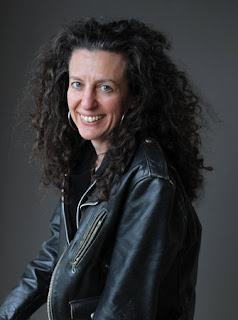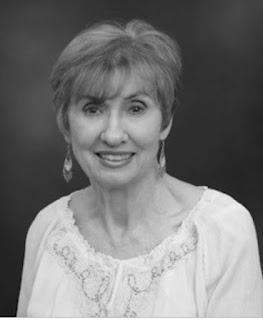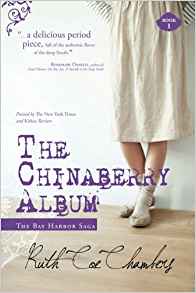 |
| B.G. Firmani, photo by Michael Lionstar |
B.G. Firmani is the author of the new novel Time's a Thief, which focuses on a young woman in 1980s New York City. Firmani's work has appeared in a variety of publications, including BOMB Magazine and Kenyon Review. She lives in New York.
Q:
How did you come up with the idea for Time’s a Thief and for your main
character, Chess?
A:
First, thank you for this interview—it’s beautiful to have thoughtful readers. There
were a lot of different things that smashed up together that led to this book.
One
really was the experience of crossing 34th Street right after the NYPD had graduated
its cadet class of 2008 and having the streets around me suddenly flooded by a
sea of blue—the visual moment of that was so striking.
(I’m
trying to remember which of the Kieślowski “Three Colors” trilogy, maybe “Blue,”
that has this crazy thing where a group of little girls with pink water-wings
suddenly runs into the frame and jumps into the pool—a sort of throwaway incursion
that’s just fantastic to the eye.)
It
stayed with me, the idea of a character being in an accidentally charged moment
and then coming into contact with a piece of “public” information that provides
a very private shock to her—in this case, the obituary of Clarice Marr, a woman
who has caused the narrator so much pain, right there on the front page of The New
York Times.
Another
current was that I’d had a notion to write a sort of retelling of Brideshead
Revisited in a late 20th century American context—the class outsider captivated
by a vivid, pedigreed, flawed family.
The
rigor around a project like that is beyond me, and also a little dreary to
contemplate, but it did help give a kind of general outline to the book: the
character Chess will be drawn to this family; she’ll “engage” with them; and
she’ll be in a way chewed up and spat out by them. But there will also remain
the romance of it, the melancholy of a lost past.
Also—structurally
speaking—when I started Time’s a Thief, I had recently read Assata Shakur’s autobiography,
a brilliant book.
She
syncopates chapters between a current reality and a past one—the past line
moves forward in time, while the present line moves backward in time until, more
or less, they meet in the middle; and then the present reality switches gears,
becoming the forward-moving narrative.
This
was a very sophisticated structure that, when I tried something like it for my
own book, of course fell to dust in my hands. But some of its armature remained—much
improved by my wise editor, Gerry Howard—and it certainly helped give me an
engine to keep the novel moving as I was writing it.
Here’s
the thing with Chess. I needed her to not have all the answers, to perhaps
think, entirely mistakenly, that she’s quite the smartie while she’s really a
sort of babe in the woods.
If
she’d had the savvy to get away from the Marr-Löwensteins and not leave herself
open to their particular brand of emotional abuse, there would be no story.
So
while I wrote it in the first person, and while we have plenty of shared
characteristics, Chess isn’t me—she’s perhaps more guileless, more porous.
She’s also struggling not to collapse under others’ notions of how she should
be.
When
the character Jerry praises her for being “so somber and quiet,” after the mean
girl at the party purposely splashes gravy on Chess, somewhere in my mind (bear
with me here) was the scene in Jane Eyre when poor old Bertha Mason, the
proverbial madwoman in the attic, is revealed to Jane, and Mr. Rochester
praises Jane for standing “so grave and quiet at the mouth of hell.”
I
love Jane Eyre, but when I was young and reading that book, I was incensed. How
can Jane remain silent? I wanted her to punch Rochester in the face for being a
lying bastard (of course, in the end he gets his terrible punishment—and also
loses the inconvenient first wife).
So,
in my book, after Jerry praises Chess for her retreating Victorian ways, I have
her explode at him. Which sounds like it would be great fun to write, but it
was pretty herky-jerky going—not terribly fluid, since so much of it had to do
with trying to keep the whine out of Chess’ voice.
I
wanted her to be strong, to stand her ground; but also she’s in love with this
man, so she’s fighting her own desire to capitulate and be the person he
imagines her to be.
Q:
What inspired the Marr-Löwenstein family, with whom Chess becomes involved, and
how would you characterize Chess’s relationship with them?
A:
Let’s maybe concentrate on the mother first, Clarice. I’ve always been
interested in power relationships, who is the dominant group, who is excluded and
oppressed; and also how such power relationships play out within an oppressed
group.
Funny
thing here: there have only been two times in my life that someone at work
asked me to get them coffee, and both of those times that someone was a woman.
Depressing, right? And completely understandable in some ways.
I
recently read an excellent article
in The Atlantic by Olga Khazan, “Why Do Women Bully Each Other at Work?” and
one of the things she talks about is the idea of the queen bee protecting her
territory—as well as the older woman coming down hard on the younger one, the
idea being that if that older woman had to struggle to get where she is, shouldn’t
the younger one know what that tastes like?
Of
course I find this both cruel and specious, but I understand its genesis.
There’s plenty of pain that a character like Clarice would be carrying; she’s
someone who cut herself off from her past and struggled to reinvent herself,
and she’s really thrilled to find a docile, dazzled Catholic girl like Chess
whom she can both mold and undermine.
As
for the Marr-Löwensteins, I do love the idea of a certain kind of big family that
creates an alluring atmosphere around them, one that’s noisy and larger than
life and has the ferment of creativity about it—so then why not, for the
purposes of fiction, imagine them rich, imagine them beautiful, and have the
dreaming class outsider press her nose up against their window?
Also,
in New York City, there’s a real mash-up of very poor and very rich and
everything in between that in some ways is hard to find anywhere else.
Even
with Manhattan being increasingly homogenized by a boring and entitled money
culture, sad to say—and I could go on until the cows come home about this clown
of a president and his racist and divisive ways—there’s still plenty of
opportunity for, as they say, a cat to look at a queen.
When
I was in grad school years back, I was missing the city so much, and I’d come
into Manhattan, get off the train, buy a bagel and walk for a hundred blocks,
taking in the city.
I’d
pass through working-poor neighborhoods, Mitchell-Lama housing, super-rich
swatches of Park Avenue—and places that to an outsider might seem down-and-out
because of the old housing stock, but that were actually hipster central—and it
would feel amazing to me how it all coexisted, for better or worse.
So
this is something, that unlikely proximity of haves and have-nots, and the
texture that such a thing produces, that I wanted to explore in the book.
Q:
How was the book’s title chosen, and what does it signify for you?
A:
Time’s a Thief is taken from the lyrics of the song “Speak Low”: Love is pure
gold/and time a thief.
I’ve
written of this elsewhere, but I first heard the song in college, in the corny
film version of “One Touch of Venus”—Ava Gardner, who is shockingly gorgeous
but sort of a big ham sandwich as an actor, is singing it in a distant duet
with Dick Haymes; she’s actually dubbed.
When
I was in graduate school, I came upon the demo version of it on vinyl, in the
listening room at the Brown library. I loved it so much it hurt. I’d put on the
headphones, drop the needle on the record, and just fly away.
Kurt
Weill wrote the music, and Ogden Nash wrote the lyrics, and the recording just
starts right in with Weill singing, no fanfare at all. He’s very close to the
microphone and it’s almost as if he’s singing to himself it feels so private.
I
think of Weill’s gentle delivery in his soft German accent, and also I can’t
help but think this: here’s a man who lost his country. Nash might have written
the lyrics, but Weill really feels them; the song is so much about what can’t
ever be regained.
My
editor Gerry is always ribbing me about my alleged smart-aleck turn of mind, but
when he finished my book he said to me (as if astonished), You know, you
actually wrote a very romantic novel! I think the title captures that.
Q:
The novel takes place in New York City. How important is setting to you in your
writing, and could this story have taken place elsewhere?
A:
Certainly such a story could take place anywhere, but it would be a much
different book. Setting’s hugely important for me, but the thing I go back to
time and again as a writer is class and ethnicity.
You
could have Chess’ story play out on a different level in some smaller
“second-tier” city; you could even have it on a micro-level in some tiny
community.
I
think of my sister Colette’s friend Sue, who grew up in a microscopic town in
West Virginia, where there were folks who lived “up the holler” and folks who
lived “down the holler.” I’d imagine the folks up the holler had some asinine
claim to superiority over those who lived down the holler.
Q:
What are you working on now?
A:
Something in the third person! It’s rather a “bigger” novel than Time’s a Thief
in that it moves among three characters. I have to say, telling a story from a
revolving point of view and being able to fly into different characters’ heads—rather
than maintain a consistent first-person voice—has really helped clear out some
mental cobwebs for me.
The
book traces these three characters’ lives from adolescence to adulthood,
mapping the choices that took them away—or nearly away—from the notions they
had of themselves when they were bright young things.
One
of the touchstones for this novel is the essay “Formulary for a New Urbanism,”
where the writer, Ivan Chtcheglov, a poet and theorist later plagued by mental
illness, has an unrealizable ideal of a city in which “…there will be rooms
more conducive to dreams than any drug, and houses where one cannot help but
love.”
These
words are beautiful to me. Of course it’s a utopian construct, and one that in
many ways mirrors each character’s purity of heart before becoming
“contaminated” by concessions they make in order to live in the world.
In
writing this book, besides having the characters’ voices differentiate
themselves one from another, one of my tasks is to register the toll that all
this living has taken on them.
So,
for instance, the language used by a dreamy idealist of sixteen walking around Passaic
County with a head full of William Carlos Williams will seem wholly alien to
the hard-edged 46-year-old shark he has become, whose time is spent greedily
calculating the split on real estate commissions.
I’m
also sort of amazed to realize how much fun it is to write from the point of
view of a really damaged character. I understand the glee behind certain of
Martin Amis’ awful male characters, I’m dismayed to report.
Q:
Anything else we should know?
A:
Just this, as inspiration for any writer out there who feels like giving up:
keep going. It took me many, many years, many pages of drivel, two thrown-out
novels, and two thrown-out books of short stories—at least—before I published
my first novel.
I
just kept writing. I had to. There was no choice. At some point I understood
that this was my path, and it was foolish to compare myself with anyone else, since
there’s only one of me.
As
a writer, you really are “competing” with no one but yourself. So put your butt
in your chair and do your work. Keep at it, sister. And don’t let the turkeys
get you down.
--Interview with Deborah Kalb





























